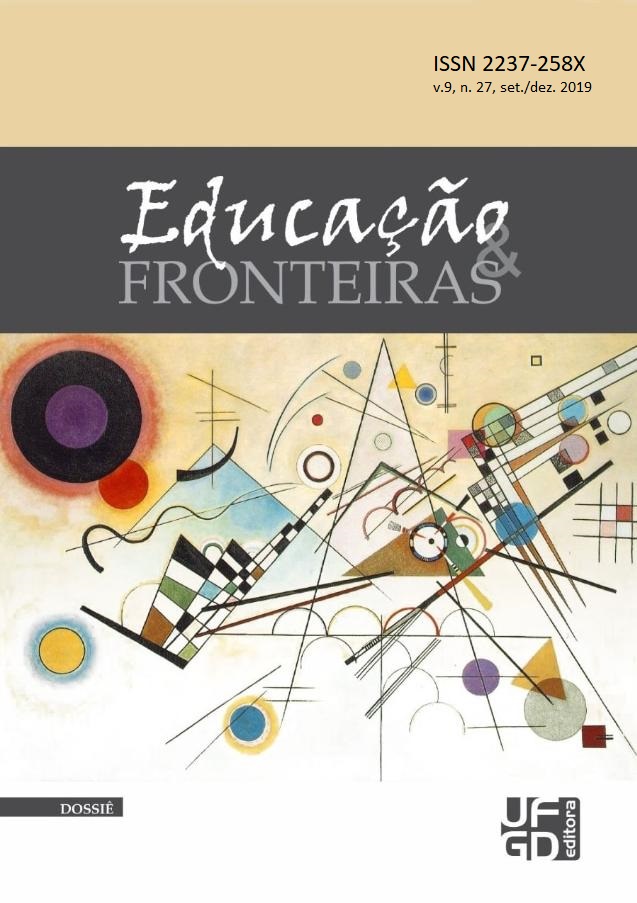Continuous formation for childhood education: ways of reflection and knowledge
DOI:
https://doi.org/10.30612/eduf.v9i27.12636Keywords:
Continuous Formation. Childhood Education. Playfulness.Abstract
Scientific, historical and cultural advances have considered a child as an individual who presents his or her own singularity. This has brought new configurations of playing as an essential tool for the childhood development. In order to reflect about these aspects, there is a university project named “Games, Toys and Kids Plays: the childhood and its singularity”, which was developed at UFMS/Navirai Campus-MS, between June to November 2019, offered in a 40-hour-course for adults including lectures, plays, games exhibitions, toys, children plays and workshops for producing educational materials. The target public are teachers, coordinators and undergraduate students from Pedagogy Course. The general aim from this work is to implement actions for teachers from childhood education by talking and discussing, selecting and producing pedagogical resources to support educational actions at Integrated Centers of Childhood Education in the city of Navirai, MS. By taking the specific objectives, it is expected to: a) debate researches about “playing” at childhood education; b) analyze games, toys, plays and methodological strategies for working with these tools at childhood education; and c) produce material for using in childhood education institutions.Downloads
References
BERNARDES, E. L. Jogos e brincadeiras: ontem e hoje. Cadernos de História da Educação, nº 4, jan./dez. 2005. Disponível em:http://www.seer.ufu.br/index.php/che/article/view/384. Acesso em: 20 jan. 2019.
BORBA,A. M. O brincar como modo de ser e estar no mundo. In: BRASIL. Ministério da Educação. Ensino fundamental de nove anos: orientações para a inclusão da criança de seis anos de idade. Brasília, DF: FNDE/Estação Gráfica, 2007.
BRASIL. Ministério da Educação. Secretaria de Educação Básica. Diretrizes Curriculares Nacionais para a Educação Infantil. Brasília, DF: MEC/SEB, 2010.
KISHIMOTO, T. M. Salas de aulas nas escolas infantis e o uso de brinquedos e materiais pedagógicos. In: 23ª REUNIÃO DA ANPED, 24 a 28 de setembro de 2000, Caxambu/MG. Anais...Caxambu, MG, 24 a 28 de setembro de 2000. Disponível em: http://23reuniao.anped.org.br. Acesso em: 20 jan. 2019.
KISHIMOTO, T. M. Brinquedos e brincadeiras na educação infantil. In: SEMINÁRIO NACIONAL: CURRÍCULO EM MOVIMENTO, Perspectivas Atuais, 2010,Belo Horizonte, MG. Anais...Belo Horizonte, novembro de 2010, p. 1-20.Disponível em: http://portal.mec.gov.br/index.php?option=com_docman&view=download&alias=7155-2-3-brinquedos-brincadeiras-tizuko-morchida&category_slug=dezembro-2010-pdf&Itemid=30192. Acesso em: 20 jan. 2019.
KISHIMOTO, T. M. Brinquedo e brincadeira−usos e significações dentro de contextos culturais. In: SANTOS, S. M. P. (Org.). Brinquedoteca − o lúdico em diferentes contextos. 14.ed. Petrópolis, RJ: Vozes, 2011.
KISHIMOTO, T. M. O jogo e a educação infantil. In: KISHIMOTO, T. M. (Org.). Jogo, brinquedo, brincadeira e a educação. 14.ed. São Paulo, SP: Cortez, 2011.
KISHIMOTO, T. M. (Org.). Jogo, brinquedo, brincadeira e a educação. 14 ed. São Paulo, SP: Cortez, 2011.
RIBEIRO, P. S. Jogos e brinquedos tradicionais. In: SANTOS, S. M. P. dos (Org.). Brinquedoteca − o lúdico em diferentes contextos. 14.ed. Petrópolis, RJ: Vozes, 2011.
SANTOS, S. M. P. dos (Org.). Brinquedoteca − o lúdico em diferentes contextos. 14.ed. Petrópolis, RJ: Vozes, 2011.
WAJSKOP, G. O brincar na educação infantil. Cadernos de Pesquisa, São Paulo/SP, n. 92, p.62-69, fev. 1995.









